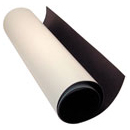
Flexible magnets have become a popular alternative to traditional, rigid magnets. As their name suggests, they are flexible. You can bend flexible magnets without breaking them. Even when bent or otherwise deformed, they will continue to produce a magnetic field while subsequently attracting ferromagnetic materials like iron and cobalt.
#1) Typically Made of Ferric Oxide With a Binder
Most flexible magnets are made of ferric oxide with a binder. Ferric oxide, of course, is one of several iron oxides. It exhibits magnetic properties that make it ideal for use in magnets, including ceramic magnets and flexible magnets. Most flexible magnets consist of a mixture of ferric oxide and a resin-based binder. The binder is designed to hold the ferric oxide particles together, whereas the ferric oxide produces the magnetic field.
#2) Available in Sheets and Rolls
When shopping for flexible magnets, you may come across sheets and rolls. Sheets are square- or rectangular-shaped flexible magnets, whereas rolls are cylindrical rolls of flexible magnets. Regardless, both sheets and rolls are flexible, and they both produce a magnetic field.
If you’re going to buy flexible magnets, you’ll need to choose between sheets and rolls. Sheets are precut, making them simple and easy to use. Rolls, on the other hand, require cutting. But you can cut rolls in custom lengths for your desired application.
#3) Durable and Long-Lasting
You can rest assured knowing that flexible magnets are durable and long-lasting. They don’t contain any oils. Rather, most flexible magnets only contain ferric oxide with a binder. With their simple construction, they will last a long time. You can use them indoors or outdoors without fear of them degrading. Whether you choose sheets or rolls, flexible magnets will last a long time — all while producing a consistent and reliable magnetic field.
#4) Commonly Used for Signs
While they support dozens of applications, flexible magnets are commonly used for signs. You can make signs out of flexible magnets. One side of flexible magnets features the ferric oxide material. The other side features a plain backing on which you can write or print signage. And with their flexible properties, flexible magnets will stick to any ferromagnetic surface.
#5) Can Be Cut and Drilled
Unlike rigid magnets, flexible magnets can be cut and drilled. Cutting or drilling into a rigid magnet may break it. The rigid magnet may split open, or it may shatter into many different pieces. This isn’t a concern with flexible magnets. Flexible magnets are safe to cut and drill.
